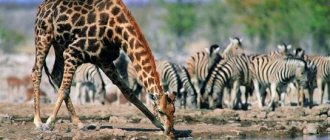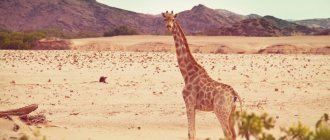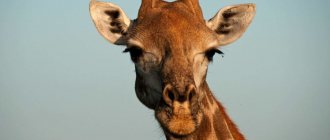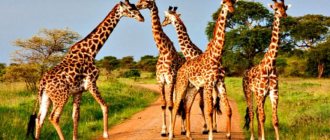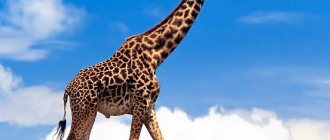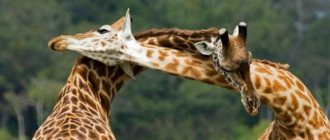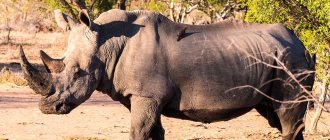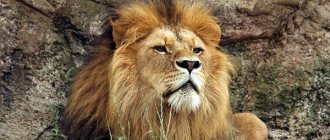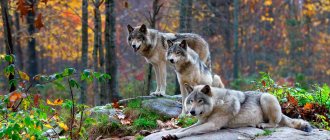07 July65308herbivorous or herbivorous artiodactylsgiraffelarge
The giraffe is a mammal from the order Artiodactyls. The giraffe is the tallest animal on the planet. The giraffe is an intelligent and peace-loving animal that has been familiar to us since childhood. In this article you will find a photo and description of a giraffe, and also learn a lot of interesting things about this unique and wonderful animal.
Description of a giraffe or what does a giraffe look like?
The description of the giraffe can begin first of all with its growth. The giraffe looks very tall. After all, the giraffe is the record holder in the animal world for height and is one of the largest animals. The giraffe grows up to 6 meters in height. The weight of a giraffe is 1 ton. Male giraffes are taller than females. In addition, females weigh slightly less.
The giraffe's height is 1/3 of its neck, which is unusually long and slender. The giraffe's neck has 7 cervical vertebrae. Many other mammals, even those with short necks, have the same number of vertebrae; it’s just that the giraffe’s vertebrae are elongated. The giraffe's neck is unusually strong, as it has strong muscles that allow it to hold its head and maneuver well.
Since giraffes are tall and have a long neck, their circulatory system works under increased stress. Therefore, giraffes have a very strong heart. The giraffe's heart weighs 12 kg and passes 60 liters of blood per minute, creating a pressure 3 times higher than that of a human.
But even such a strong heart of a giraffe cannot withstand overload if the animal suddenly lowers and raises its head. Nature made sure that such stress did not have dire consequences and made the giraffe’s blood thicker. In addition, it contains 2 times more blood cells than a person. The giraffe also has special valves that help keep the pressure in the main artery at the same level.
The giraffe looks unusual not only because of its height. The giraffe's strong body is covered with short hair. The color of the giraffe's coat adds to the uniqueness of the giraffe's appearance. The coat pattern of each giraffe is formed by a unique pattern of dark spots that stand out against the background of a light shade of the base color. This pattern is absolutely unique, like a human fingerprint. From below, the giraffe's body is lighter in color and has no spots. Young individuals are lighter in color than older ones.
The giraffe looks funny, because its head with small ears has two horns covered with hair. Both sexes have horns. Females have thinner horns and have tassels. In males they are thicker and the coat is smoother. Occasionally, giraffes have two pairs of horns. Giraffes often have a convex bone growth on their forehead that looks like a horn. The giraffe looks charming, because its huge black eyes have thick eyelashes. The giraffe has a thin, long tail with a black tassel at the end and a small short mane on its neck.
Giraffes have good eyesight, hearing and smell; such abilities help them spot danger in time. And of course, the large growth of giraffes allows for a good overview of the area. Giraffes can see each other at a distance of up to a kilometer. The giraffe's tongue is dark in color, often with a purple tint. The giraffe's tongue is 45 cm long and helps the animal grab branches. The giraffe's long neck allows it to reach the highest crowns.
The giraffe's legs are strong and high, with the front ones being longer than the back ones. Giraffes run fast. If necessary, the giraffe can gallop at a speed of up to 55 km/h. Thus, the animal giraffe can outrun a racehorse in short distances. But most often, giraffes move slowly, first moving their two right hooves, then both left ones. When walking this way, the giraffe's speed is up to 7 km/hour.
Since the giraffe has a lot of weight and thin legs, it moves only on a hard surface. Therefore, the animal giraffe avoids swampy areas. Rivers are almost insurmountable for giraffes. It is noteworthy that these huge animals can jump over barriers up to 180 cm high.
Types of giraffes
Currently there are 4 species of giraffes and 9 subspecies. They all differ in the pattern of their fur and the color of their spots. Giraffe species are divided into: southern giraffes, Masai giraffes, reticulated giraffes and northern giraffes.
Modern giraffe subspecies include the Nubian giraffe, West African giraffe, Kordofan giraffe, reticulated giraffe, Ugandan or Rothschild's giraffe, Masai giraffe, Thorneycroft's giraffe, Angolan giraffe and South African giraffe.
Where do giraffes live and how?
Giraffes live in Africa, living in its arid parts. Today, giraffes live south and southeast of the Sahara. Giraffes live in savannas and woodlands, primarily in Eastern and Southern Africa.
In the 20th century, the number of giraffes decreased significantly due to uncontrolled hunting, various diseases and the destruction of natural habitats. Today, the largest number of giraffes live in protected areas of national parks. Giraffes are one of the few animals that feel good in captivity and regularly bear offspring.
Giraffes live practically without sleep; among all mammals they have the least need for it. A giraffe sleeps on average no more than 2 hours a day. But sometimes a 10-minute nap is enough for them. Surely everyone has wondered how giraffes sleep? They're so tall. Giraffes sleep both standing and lying down. In a lying position, a sleeping giraffe bends its neck, tucks its legs and rests its head on its rump.
Giraffes live in small herds or alone. There is no strict loyalty in herds. Everyone can freely leave the herd or also freely move to another. The size of the herd varies depending on the season and can range from 4 to 32 individuals. A herd of giraffes can consist of individuals of different sexes or of the same sex. In search of food, the giraffe animal can travel up to 100 km². Quite often you can see giraffes moving along with herds of antelope or zebra. This way they are safer.
The hierarchy and social behavior of giraffes in a herd are not yet fully understood. Although giraffes do not have a main leader, older and stronger males have an advantage over others. Also in herds where there are only females, the oldest female takes the lead. When two adult males meet, skirmishes often occur between them. In a duel, they try to headbutt each other in the neck. Despite this, defeated males are not expelled from the herd, unlike other social animals, such as wolves.
The mating season is also often accompanied by fights between males, but at this time they become much more aggressive. Opponents can sort things out near a tree, with each trying to press the opponent to the trunk and deliver a headbutt to the neck. Fortunately, giraffes do not use their main weapon on each other - dangerous blows with their front hooves. At least such cases have not been observed. They usually use their hooves to defend themselves against predators. The winner does not pursue the defeated male.
Giraffes are mistakenly considered voiceless animals. They simply communicate with each other at low frequencies, which are indistinguishable to human hearing. However, giraffes do make sounds that we can hear. They can snort, whistle and roar, thus alerting their relatives in case of danger, as well as when searching for lost cubs.
Very often you can see various small birds on the backs of giraffes. There is a friendship between giraffes and these birds that is built on mutual assistance. These birds clean the giraffe's back and neck of insects. In this way, giraffes get rid of parasites, and birds get food.
Natural enemies
Their large size and natural strength scare away many savannah inhabitants from giraffes, and they have almost no natural enemies. However, some predators risk attacking young individuals that have not yet fully formed. Sick and elderly individuals are also at risk. Natural enemies include:
- Leopards.
- Lions.
- Hyenas.
- Cheetahs.
- Crocodiles at watering holes.
Giraffes usually win battles with predators. Their advantage is provided by strong legs, the blow of which can discourage the attackers from any desire to continue hunting. Sometimes the first blow is so powerful that it becomes fatal, especially if it hits the head.
The greatest threat to giraffes is lions. These strong animals try to get behind them so that the giraffe cannot repel the attack. When hunting, hyenas gather in packs, and can also be dangerous if there are no relatives nearby who can come to the giraffe’s aid.
What do giraffes eat?
The giraffe is a herbivore animal. Therefore, giraffes eat exclusively plant foods. Due to their body structure and physiology, giraffes eat the foliage of tree crowns located at considerable heights, where there is no competition. Giraffes eat acacia, giving the greatest preference to this tree.
The giraffe grabs the branch with its long tongue and pulls it towards its mouth to pluck the leaves, while pulling its head back. The acacia tree has thorny branches, but the giraffe's tongue and lips are designed in such a way that they allow feeding without damage.
A giraffe eats up to 30 kg of food per day, spending most of its time eating. In times of famine, 7 kg of food is enough for a giraffe. It is curious that by the way giraffes eat, you can determine the sex of the animal from a distance. Male giraffes eat mainly very high-growing leaves, while they strongly stretch their necks and throw back their heads. Female giraffes eat leaves that grow at the level of their body, so they usually lower their necks slightly.
The animal giraffe can go without water even longer than a camel. After all, food completely covers his need for liquid. However, if a giraffe has the opportunity to drink, it can drink up to 38 liters of water at a time. To drink water, a giraffe must spread its front legs wide apart and lower its head quite low. This position makes the giraffe clumsy and vulnerable to predators, so giraffes drink only when they are confident in their safety. In the same position, giraffes pluck grass when hungry.
Population status
Giraffes are good-natured and peace-loving creatures. They do not get involved in conflicts and get along well with people if they meet them along the way. At the same time, giraffes are quite curious and may even be the first to make contact. However, their population in the wild is constantly decreasing, which is due to two factors:
- Poaching.
- Anthropogenic influence.
Both factors are associated with human influence on the lives of these animals. Poachers hunt giraffes as a valuable trophy due to the attractiveness of their durable and unusual skin. The skin of giraffes is so thick that in the wild it is quite difficult for predators to bite through it, and they are not at all afraid of accidental cuts and abrasions. In 1985, the giraffe population was about 160 thousand, and in 2016 it dropped to 97 thousand. Despite the fact that hunting is currently prohibited and is monitored by nature conservation services, there are still poachers hunting these animals.
Adding to this problem is the pollution of the giraffes' natural habitat, as well as the reduction of their areola. The latter is due to the growth of industry, which takes away entire territories from animals that were their usual place. All this reduces the life expectancy of giraffes and negatively affects their feeding behavior and ecology.
Giraffes are listed in the Red Book and are listed in the “vulnerable” section. Previously, they were placed there under the status of “least concern.”
The optimal way to preserve the population is to place giraffes in nature reserves and national parks. These places have created favorable conditions for breeding offspring, good environmental conditions and protection from poachers.
Giraffes are friendly towards people
Baby giraffe
Giraffes are polygamous animals. Females become capable of reproduction at the age of 3-4 years, but produce offspring for the first time by 5 years. In males, the breeding season begins at the age of 4-5 years. Young males find it difficult to compete with older males. Therefore, young animals can acquire offspring only by the age of 7 years.
The mating season for giraffes is from July to September. The duration of a giraffe's pregnancy is 14-15 months. Usually only one giraffe calf is born. Giraffes give birth standing up, which means that a giraffe calf falls from a height of about 2 meters at birth. There is no need to worry; the baby giraffe does not suffer any injuries from the fall.
A born giraffe calf is 180 cm tall and weighs 50 kg. An hour after birth, the cub gets on its feet, and after a few more hours it can run. Giraffe cubs are only allowed into the general herd after a few weeks, at which time they begin to browse the grass. But the baby giraffe will feed on mother’s milk until almost 1 year of age.
Giraffes have nurseries to which females send their young. In this way, mothers may separate from their young to find food and water. Monitoring duty over a group of cubs occurs between mothers in turns.
Giraffe cubs are born without horns, but where they appear there is a tuft of dark hair, under which there is cartilage. As they grow older, the cartilages harden into horns that begin to grow. Tufts of black fur at the base of the horns remain with the cub for several years, after which they disappear.
Giraffe cubs grow quickly, they are mobile and very active. Until approximately 1.5 years of age, the giraffe calf remains with its mother. After which he begins an independent life. Males usually leave their native herd, but females almost always remain in it. In the wild, giraffes live for about 25 years, and in captivity up to 35 years.
Due to its considerable size, the giraffe animal has practically no natural enemies. Giraffes defend themselves from predators by striking their front hooves. Such a blow can break the skull of any predator, although there are cases of predators defeating giraffes.
Few predators are willing to take risks, so attacks on adults are rare. Predators most often attack young animals. Despite the mother's protection, up to 50% of young giraffes become prey to lions, leopards, hyenas and wild dogs.
Don’t forget to subscribe to updates on our website and join us on social networks (Vkontakte, Odnoklassniki, Instagram) so you don’t miss anything and always stay up to date with all the news!
Don't forget to share with your friends!
Interesting Facts
- A characteristic feature of the giraffe is the gradual accumulation of bone material around the skull, especially in males, which is why there are specimens with three or even five horns.
- Over the past 40 years, giraffe numbers have declined by approximately 50% due to habitat loss.
- Giraffes can reach a maximum speed of 65 km/h and maintain a constant speed of 54 km/h for several kilometers.
- Giraffes have only one natural enemy - the lion.
- The first giraffe came to Europe from Alexandria thanks to Julius Caesar.
- The Latin name (camelopardalis) comes from the idea that the giraffe is part camel and part leopard (Camelus + pardus).
All articles
